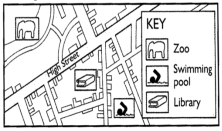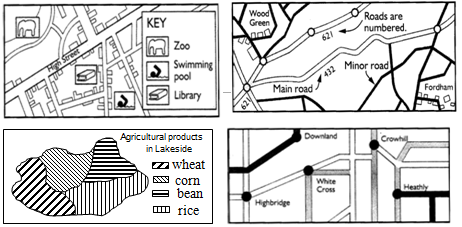-
I have a rule for travel: never carry a map. I prefer to ask for directions.
Foreign visitors are often puzzled (迷惑的) in Japan because most streets there don’t have names. In Japan, people use landmarks in their directions instead of street names. For example, the Japanese will say to travelers, “Go straight down to the corner. Turn left at the big hotel and go pass a fruit market. The post office is across from the bus stop.”
In the countryside of the American Midwest, usually there are not many landmarks. There are no mountains, so the land is very flat (平坦的). In many places there are no towns or buildings within miles. Instead of landmarks, people will tell you directions and distance. In Kansas or lowa, for example, people will say, “Go north two miles. Turn east, and then go another mile.”
People in Los Angeles, California, have no idea of distance on the map: the measure (测量) distance by means of time, not miles. “How far away is the post office?” you ask. “Oh,” they answer, “it’s about five minutes from here.” you say, “Yes, but how many miles away is it?” They don’t know.
People in Greece sometimes do not even try to give directions because visitors seldom understand the Greek language. Instead of giving you the direction, a Greek will often say, “Follow me.” Then he’ll lead you through the streets of the city to the post office.
Sometimes a person doesn’t know the answer to your question. What happen in this situation? A New Yorker might say, “sorry, I have no idea.” But in Yucatan, Mexico, no one answer, “I don’t know.” They think that it is impolite. They usually give an answer, often a wrong one. A visitor can get lost in Yucatan.
One thing will help you everywhere. You might not understand a person’s words, by maybe you can understand his body language. He or she will usually turn and then point in the correct direction.
1.What does the passage mainly talk about?
A. we needn’t carry a map for travel.
B. There are not many landmarks in the American Midwest.
C. There are different ways to give directions in different parts of the world.
D. Americans and Japanese have different body languages when you ask for directions.
2.What does the underlined word “landmarks” mean?
A. Building names
B. Street names
C. Hotels
D. Buildings or places which are easily seen
3. How many ways of giving directions in the passage?
A. Four B. Five C. Six D. seven
4.Why does a traveler get lost in Yucatan?
A. People in Yucatan don’t know what the traveler said, so they give a wrong answer.
B. People in Yucatan think that “I don’t know” is impolite, so they give a wrong answer.
C. People in Yucatan like making a joke, so they usually give a wrong answer.
D. People in Yucatan are bad men, so they usually give a wrong answer.
5. Which of the following is WRONG?
A. People in some places give directions in miles but people in other places give directions by means of time.
B. Travelers can learn about people’s customs by asking questions for directions.
C. People in different places give directions in different ways.
D. A person’s body language can help you understand directions.
九年级英语阅读理解中等难度题查看答案及解析
-
– What do we have to carry with while traveling abroad?
– We all have to carry our with us.
A. cameras B. umbrellas C. passports D. maps
九年级英语单项填空中等难度题查看答案及解析
-
Have you ever been to Hong Kong? When you travel in Hong Kong, you must____of the traffic rules, because they are different from those of the interior (内地) of China, and the traffic keeps to_____. Before_____the street, you must look to the right and then to the left. If the traffic lights turn _____, the traffic must stop, and people can cross the zebra line. If the traffic lights turn _____, the traffic can go, but people_____cross the road. In the morning and in the evening, when people go to or come from _____, the streets are very busy. The traffic is_____.
When you go somewhere by bus in Hong Kong, you must be careful,_____.Always remember the traffic keeps to the left. Have a look first, or you may go to the wrong way. In Hong Kong, there are a lot of big buses______two floors. You may sit on the second floor. From there you can watch the city very well.
1.A. careless B. be carefully C. be careful D. careful
2.A. the left B. left C. the right D. right
3.A. across B. cross C. crossed D. crossing
4.A. yellow B. green C. red D. red and yellow
5.A. orange B. red and yellow C. green D. red
6.A. may not B. not C. aren’t D. mustn’t
7.A. sea B. work C. hotel D. school
8.A. the most dangerous B. dangerousest C. the dangerous D. most dangerous
9.A. too B. also C. either D. but
10.A. with B. in C. having D. being
九年级英语完型填空简单题查看答案及解析
-
If you are asked to chair a meeting, remember the following six golden rules for meeting management.
Always start the meeting on time. If you begin on time, group members who show up late will realize the value of time. Beginning on time shows the skill as an effective time manager and sets an example for others to follow.
Select a note-taker or have the meeting recorded. You may need to go back to something that was discussed during the meeting at a later date. Good record-keeping is a sign of a good meeting manager as well.
Learn to listen. So many times we think about what we are going to say and, in the process, miss important points that other group members may be contributing (做贡献). What’s more, we often hear only what we want to hear, instead of really listening to other people. Meetings with effective listening are successful meetings.
Keep the discussion on track(轨道). Many times an important topic can get sidetracked(转变话题) in a meeting, especially when everyone has a different opinion about the topic. Ask members who have different opinions to meet with you after the meeting. Doing so will help keep the discussion on track and reduce the chances of wasting group members’ time of great value.
Give everyone an opportunity to be heard. Some people like to control meetings, while others wait to be asked their opinions. As the leader of the meeting, you need to keep an open mind and make sure everyone feels welcome to contribute and express ideas freely.
End on time. If you said the meeting would last no longer than one hour, make sure the meeting lasts for only one hour. Running late with a meeting makes members late for other appointments, increases the chances that the members will mentally leave the meeting and reduces your reliability as an effective meeting manager.
Title: ___1.___ on How to Manage a Meeting
____2.___
Reasons
Start the meeting on time
Show the skill and__3.___ an example.
Select a note-taker or have someone ___4.__the meeting.
Need to go back to something that was discussed during the meeting __5._____.
Learn to listen.
Listen effectively to make sure every meeting is a ____6.___.
Keep the ___7.___ on track.
Reduce the chances of wasting group members’ ___8._____ time.
Give everyone an opportunity to be__9.____.
Make sure everyone feels ____10._____ to speak.
End on time
Increase your reliability.
九年级英语其他题中等难度题查看答案及解析
-
Different types of maps have different uses. Tourist maps, for example, have signs to show places of interest in an area. When tourists read these maps, it is easy for them to find where to go and what to see in a place and it is easy for them to go and find their ways to these places.

Road maps show large areas so that people can plan long journeys. Different types of roads are given different numbers. For example, if you want to go to Wood Green, you just follow No. 621 Road and keep looking at the road signs.

Distribution maps(分布图) use colors or signs to show facts about an area. For example, where different languages are spoken, how many people live in an area, how cold and hot some places are, or whether a place is short of water.

Some maps, such as railway maps, use straight lines to show everything. This is easy for people to read. Trains are fast. People don’t have to think about small places they go past. They just need to know the two ends of their trips.

1.Jim is visiting the Summer Palace. Which map does he need most?
A. A tourist map. B. A railway map.
C. A distribution map. D. A road map.
2.How can you tell different roads on road maps?
A. By using different colors. B. By finding the numbers.
C. By following No. 621 Road. D. By looking at the road signs.
3. Which of the following can distribution maps tell us?
A. How to get to Lakeside.
B. How to plan a long journey.
C. Where a famous museum is.
D. How many people live in a place.
4.Why do railway maps use straight lines?
A. Because railways are straight.
B. Because people can read them easily.
C. Because people like straight lines.
D. Because railways have only two ends.
九年级英语阅读理解中等难度题查看答案及解析
-
Different types of maps have different uses. Tourist maps, for example, have signs to show places of interest in an area. When tourists read these maps, it is easy for them to find where to go and what to see in a place and it is easy for them to go and find their ways to these places.

Road maps show large areas so that people can plan long journeys. Different types of roads are given different numbers. For example, if you want to go to Wood Green, you just follow No. 621 Road and keep looking at the road signs.
Distribution maps(分布图) use colors or signs to show facts about an area. For example, where different languages are spoken, how many people live in an area, how cold and hot some places are, or whether a place is short of water.
Some maps, such as railway maps, use straight lines to show everything. This is easy for people to read. Trains are fast. People don’t have to think about small places they go past. They just need to know the two ends of their trips.
1.Jim is visiting the Summer Palace. Which map does he need most?
A. A tourist map. B. A railway map.
C. A distribution map. D. A road map.
2.How can you tell different roads on road maps?
A. By using different colors. B. By finding the numbers.
C. By following No. 621 Road. D. By looking at the road signs.
3.Which of the following can distribution maps tell us?
A. How to get to Lakeside. B. How to plan a long journey.
C. Where a famous museum is. D. How many people live in a place.
4.Why do railway maps use straight lines?
A. Because railways are straight.
B. Because people can read them easily.
C. Because people like straight lines.
D. Because railways have only two ends.
九年级英语阅读理解中等难度题查看答案及解析
-
Different types of maps have different uses.Tourist maps, for example, have signs to show places of interest in an area. When tourists read these maps, it is easy for them to find where to go and what to see in a place and it is easy for them to go and find their ways to these places.

Road maps show large areas so that people can plan long journeys. Different types of roads are given different numbers. For example, if you want to go to Wood Green, you just follow No. 621 Road and keep looking at the road signs.

Distribution maps(分布图)use colors or signs to show facts about an area. For example, where different languages are spoken, how many people live in an area, how cold and hot some places are, or whether a place is short of water.

Some maps, such as railway maps, use straight lines to show everything. This is easy for people to read. Trains are fast. People don’t have to think about small places they go past. They just need to know the two ends of their trips.

1.Jim is visiting the Summer Palace. Which map doeshe need most?
A.A tourist map.
B.A railwaymap.
C.A distribution map.
D.A road map.
2.How can you tell different roads on road maps?
A.By using different colors.
B.By finding the numbers.
C.By following No. 621 Road.
D.By looking at the road signs.
3.Which of the following can distribution maps tell us?
A.How to get to Lakeside.
B.How to plan a long journey.
C.Where a famous museum is.
D.How many people live in a place.
4.Why do railway maps use straight lines?
A.Because railways are straight.
B.Because people canread them easily.
C.Because people like straight lines.
D.Because railways have only two ends.
九年级英语阅读理解中等难度题查看答案及解析
-
–This box is too heavy for me to carry upstairs. –__________
A. You may ask for help B. I’ll give you a hand
C. Please do me a favor D. I’d come to help
九年级英语单项填空极难题查看答案及解析
-
一Lucy and Lily have never had Chinese food,have they?
一 . They want to travel around China again.
A. Yes,they have B. I don't think so
C. Yes,I hope so D. No,they haven't
九年级英语单选题中等难度题查看答案及解析
-
—Li Ping went to Australia to study and travel last year.
—Yes, I know. He told me he would never forget his meaningful ________ there.
A.explorations B.expressions
C.experiences D.Experiments
九年级英语单项填空简单题查看答案及解析